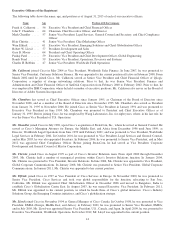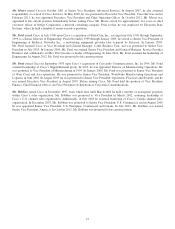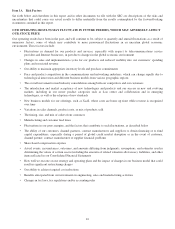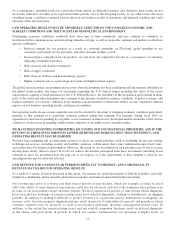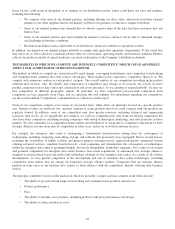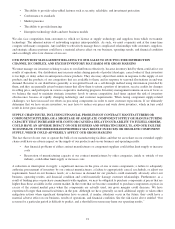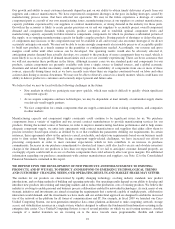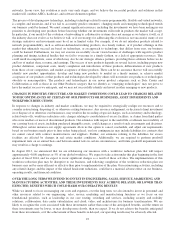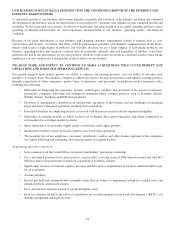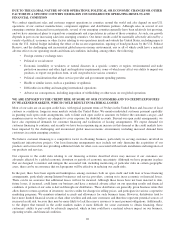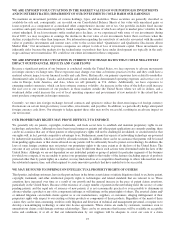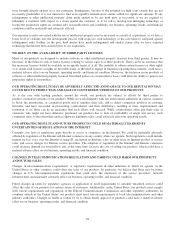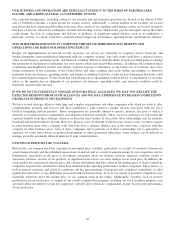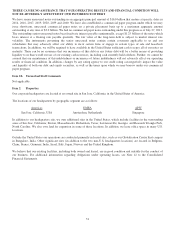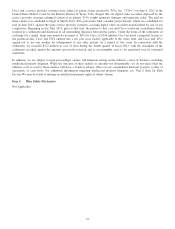Cisco 2013 Annual Report Download - page 31
Download and view the complete annual report
Please find page 31 of the 2013 Cisco annual report below. You can navigate through the pages in the report by either clicking on the pages listed below, or by using the keyword search tool below to find specific information within the annual report.networks. In our view, this evolution is in its very early stages, and we believe the successful products and solutions in this
market will combine ASICs, hardware, and software elements together.
The process of developing new technology, including technology related to more programmable, flexible and virtual networks,
is complex and uncertain, and if we fail to accurately predict customers’ changing needs and emerging technological trends
our business could be harmed. We must commit significant resources, including the investments we have been making in our
priorities to developing new products before knowing whether our investments will result in products the market will accept.
In particular, if our model of the evolution of networking to collaborative systems does not emerge as we believe it will, or if
the industry does not evolve as we believe it will, or if our strategy for addressing this evolution is not successful, many of our
strategic initiatives and investments may be of no or limited value. For example, if we do not introduce products related to
network programmability, such as software-defined-networking products, in a timely fashion, or if product offerings in this
market that ultimately succeed are based on technology, or an approach to technology, that differs from ours, our business
could be harmed. Furthermore, we may not execute successfully on our vision because of challenges with regard to product
planning and timing, technical hurdles that we fail to overcome in a timely fashion, or a lack of appropriate resources. This
could result in competitors, some of which may also be our strategic alliance partners, providing those solutions before we do
and loss of market share, revenue, and earnings. The success of new products depends on several factors, including proper new
product definition, component costs, timely completion and introduction of these products, differentiation of new products
from those of our competitors, and market acceptance of these products. There can be no assurance that we will successfully
identify new product opportunities, develop and bring new products to market in a timely manner, or achieve market
acceptance of our products or that products and technologies developed by others will not render our products or technologies
obsolete or noncompetitive. The products and technologies in our newer product categories such as Data Center and
Collaboration as well as those in our Other Products category that we identify as “emerging technologies” may not prove to
have the market success we anticipate, and we may not successfully identify and invest in other emerging or new products.
CHANGES IN INDUSTRY STRUCTURE AND MARKET CONDITIONS COULD LEAD TO CHARGES RELATED
TO DISCONTINUANCES OF CERTAIN OF OUR PRODUCTS OR BUSINESSES, ASSET IMPAIRMENTS AND
WORKFORCE REDUCTIONS
In response to changes in industry and market conditions, we may be required to strategically realign our resources and to
consider restructuring, disposing of, or otherwise exiting businesses. Any resource realignment, or decision to limit investment
in or dispose of or otherwise exit businesses, may result in the recording of special charges, such as inventory and technology-
related write-offs, workforce reduction costs, charges relating to consolidation of excess facilities, or claims from third parties
who were resellers or users of discontinued products. Our estimates with respect to the useful life or ultimate recoverability of
our carrying basis of assets, including purchased intangible assets, could change as a result of such assessments and decisions.
Although in certain instances our supply agreements allow us the option to cancel, reschedule, and adjust our requirements
based on our business needs prior to firm orders being placed, our loss contingencies may include liabilities for contracts that
we cannot cancel with contract manufacturers and suppliers. Further, our estimates relating to the liabilities for excess
facilities are affected by changes in real estate market conditions. Additionally, we are required to perform goodwill
impairment tests on an annual basis and between annual tests in certain circumstances, and future goodwill impairment tests
may result in a charge to earnings.
In August 2013, we announced that we are rebalancing our resources with a workforce reduction plan that will impact
approximately 4,000 employees or 5% of our global workforce. We expect to take action under this plan beginning in the first
quarter of fiscal 2014, and we expect to incur significant charges as a result of these activities. The implementation of this
workforce reduction plan may be disruptive to our business, and following completion of the workforce reduction plan our
business may not be more efficient or effective than prior to implementation of the plan. Our restructuring activities, including
any related charges and the impact of the related headcount reductions, could have a material adverse effect on our business,
operating results, and financial condition.
OVER THE LONG TERM WE INTEND TO INVEST IN ENGINEERING, SALES, SERVICE, MARKETING AND
MANUFACTURING ACTIVITIES, AND THESE INVESTMENTS MAY ACHIEVE DELAYED, OR LOWER THAN
EXPECTED, BENEFITS WHICH COULD HARM OUR OPERATING RESULTS
While we intend to focus on managing our costs and expenses, over the long term, we also intend to invest in personnel and
other resources related to our engineering, sales, service, marketing and manufacturing functions as we focus on our
foundational priorities, such as leadership in our core routing, switching and services, including security and mobility
solutions; collaboration; data center virtualization and cloud; video; and architectures for business transformation. We are
likely to recognize the costs associated with these investments earlier than some of the anticipated benefits, and the return on
these investments may be lower, or may develop more slowly, than we expect. If we do not achieve the benefits anticipated
from these investments, or if the achievement of these benefits is delayed, our operating results may be adversely affected.
23



